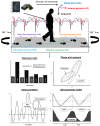Gait Asymmetry Post-Stroke: Determining Valid and Reliable Methods Using a Single Accelerometer Located on the Trunk
- PMID: 31861630
- PMCID: PMC6983246
- DOI: 10.3390/s20010037
Gait Asymmetry Post-Stroke: Determining Valid and Reliable Methods Using a Single Accelerometer Located on the Trunk
Abstract
Asymmetry is a cardinal symptom of gait post-stroke that is targeted during rehabilitation. Technological developments have allowed accelerometers to be a feasible tool to provide digital gait variables. Many acceleration-derived variables are proposed to measure gait asymmetry. Despite a need for accurate calculation, no consensus exists for what is the most valid and reliable variable. Using an instrumented walkway (GaitRite) as the reference standard, this study compared the validity and reliability of multiple acceleration-derived asymmetry variables. Twenty-five post-stroke participants performed repeated walks over GaitRite whilst wearing a tri-axial accelerometer (Axivity AX3) on their lower back, on two occasions, one week apart. Harmonic ratio, autocorrelation, gait symmetry index, phase plots, acceleration, and jerk root mean square were calculated from the acceleration signals. Test-retest reliability was calculated, and concurrent validity was estimated by comparison with GaitRite. The strongest concurrent validity was obtained from step regularity from the vertical signal, which also recorded excellent test-retest reliability (Spearman's rank correlation coefficients (rho) = 0.87 and Intraclass correlation coefficient (ICC21) = 0.98, respectively). Future research should test the responsiveness of this and other step asymmetry variables to quantify change during recovery and the effect of rehabilitative interventions for consideration as digital biomarkers to quantify gait asymmetry.
Keywords: accelerometer; asymmetry; gait; reliability; stroke; trunk; validity.
Conflict of interest statement
The authors declare no conflict of interest.
Figures





Similar articles
-
Comprehensive measurement of stroke gait characteristics with a single accelerometer in the laboratory and community: a feasibility, validity and reliability study.J Neuroeng Rehabil. 2017 Dec 29;14(1):130. doi: 10.1186/s12984-017-0341-z. J Neuroeng Rehabil. 2017. PMID: 29284544 Free PMC article.
-
Test-Retest Reliability and Concurrent Validity of a Single Tri-Axial Accelerometer-Based Gait Analysis in Older Adults with Normal Cognition.PLoS One. 2016 Jul 18;11(7):e0158956. doi: 10.1371/journal.pone.0158956. eCollection 2016. PLoS One. 2016. PMID: 27427965 Free PMC article.
-
Test-Retest Reliability of an Automated Infrared-Assisted Trunk Accelerometer-Based Gait Analysis System.Sensors (Basel). 2016 Jul 23;16(8):1156. doi: 10.3390/s16081156. Sensors (Basel). 2016. PMID: 27455281 Free PMC article.
-
Validity of gait asymmetry estimation by using an accelerometer in individuals with hemiparetic stroke.J Phys Ther Sci. 2017 Feb;29(2):307-311. doi: 10.1589/jpts.29.307. Epub 2017 Feb 24. J Phys Ther Sci. 2017. PMID: 28265163 Free PMC article.
-
Differences in gait and trunk movement between patients after ankle fracture and healthy subjects.Biomed Eng Online. 2019 Mar 19;18(1):26. doi: 10.1186/s12938-019-0644-3. Biomed Eng Online. 2019. PMID: 30890177 Free PMC article.
Cited by
-
Differences in Trunk Acceleration-Derived Gait Indexes in Stroke Subjects with and without Stroke-Induced Immunosuppression.Sensors (Basel). 2024 Sep 17;24(18):6012. doi: 10.3390/s24186012. Sensors (Basel). 2024. PMID: 39338758 Free PMC article.
-
Periodicity Intensity of the 24 h Circadian Rhythm in Newborn Calves Show Indicators of Herd Welfare.Sensors (Basel). 2022 Aug 4;22(15):5843. doi: 10.3390/s22155843. Sensors (Basel). 2022. PMID: 35957398 Free PMC article.
-
Inertial measurement units to evaluate the efficacity of Equino Varus Foot surgery in post stroke hemiparetic patients: a feasibility study.J Neuroeng Rehabil. 2024 Oct 16;21(1):182. doi: 10.1186/s12984-024-01469-9. J Neuroeng Rehabil. 2024. PMID: 39407309 Free PMC article.
-
An Acceleration Based Fusion of Multiple Spatiotemporal Networks for Gait Phase Detection.Int J Environ Res Public Health. 2020 Aug 5;17(16):5633. doi: 10.3390/ijerph17165633. Int J Environ Res Public Health. 2020. PMID: 32764244 Free PMC article.
-
Identifying the Effects of Age and Speed on Whole-Body Gait Symmetry by Using a Single Wearable Sensor.Sensors (Basel). 2022 Jul 2;22(13):5001. doi: 10.3390/s22135001. Sensors (Basel). 2022. PMID: 35808494 Free PMC article.
References
-
- Moore S.A., Hickey A., Lord S., Del Din S., Godfrey A., Rochester L. Comprehensive measurement of stroke gait characteristics with a single accelerometer in the laboratory and community: A feasibility, validity and reliability study. J. Neuroeng. Rehabil. 2017;14:130. doi: 10.1186/s12984-017-0341-z. - DOI - PMC - PubMed
-
- Bull F., Goenka S., Lambert V., Pratt M. Physical Activity for the Prevention of Cardiometabolic Disease. The International Bank for Reconstruction and Development/The World Bank; Washington, DC, USA: 2017. - PubMed
LinkOut - more resources
Full Text Sources

